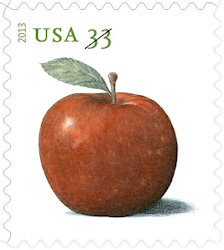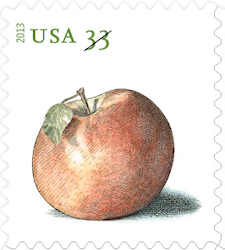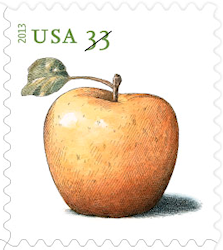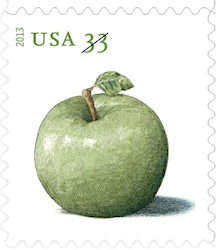
 |
All About Apples
By Allison W. Cusick The U.S. Postal Service is issuing four apple stamps for the 2013 postcard rate, 33 cents. The artwork is by John Burgoyne, with the stamps designed by Derry Noyes. You'll find more details about the stamps in our message board and 2013 U.S. Stamp Program, but well-known first day cover collector Allison Cusick, a retired state botanist, serves up details on the stamp subjects.
The U.S. Postal Service is issuing four apple stamps for the 2013 postcard rate, 33 cents. The artwork is by John Burgoyne, with the stamps designed by Derry Noyes. You'll find more details about the stamps in our message board and 2013 U.S. Stamp Program, but well-known first day cover collector Allison Cusick, a retired state botanist, serves up details on the stamp subjects.Although there is only a single species of apple, more than 7,500 variants of apple are in cultivation today. At least this many more may have existed in the past but have since gone extinct. This is because the apple is excessively prone to spontaneous mutations, "sports" as the orchardists call them. A single branch of a tree may on occasion produce a variant of the parent tree. This branch can be cloned through cuttings or tissue culture into a new cultivar. Apples have extremely high numbers of genes, the reason for which is unknown. In 2010 the genome of the Golden Delicious apple was decoded and discovered to contain about 57,000 genes, the highest number of any plant genome studied to date.
The proper scientific name for the apple is in dispute as of this date. Many authorities, including me, prefer to use Malus pumila Miller, while others opt for Malus Xdomestica Borkh. Wikipedia chooses the latter, but omits the important "X" which indicates the species' hybrid origin.
Apples apparently evolved in western Asia with the center of diversity in what today is Kazakhstan and eastern Turkey. They probably were the first fruit trees to be cultivated by humans. The word "apple" appears eight times in the King James Bible, but apples did not grow in the Holy Land during Biblical times. The translation is an error for either apricot or pomegranate. Apples are not native to the New World. In North America, we have several species of wild crab apples, also in the genus Malus, but they are not close relatives of the cultivated apple.
The commercial apples in today's supermarkets are a triumph of breeding and aesthetics. Most would not be recognized by shoppers from a century ago. Alas, in making the trees more prolific and the fruits more attractive, taste and texture have been left behind. This especially is evident in the Red Delicious apple. Discovered in Iowa in 1880, it reportedly was quite tasty. Since World War II, however, breeders have emphasized the odd, elongated shape and the bright color of the thick, waxy peel. The result is an apple which aficionados derisively call the "Red Disgusting" with a skin impossible to chew and a Styrofoam texture void of flavor. Apples grown by individual farmers in their own orchards give us a sense of what we have lost to industrialization.

The Baldwin apple (left) is an heirloom cultivar discovered near Wilmington in western Massachusetts in the mid 18th Century. The locals kept it to themselves at first. They called it the Pecker Apple from the woodpeckers which swarmed about the tree. Col. Loammi Baldwin of Woburn, Mass., took an interest in the apple and brought it into commerce. The Baldwin was favored mostly for cider, especially hard cider. I'm told it is not a good eating apple because of its very dense, almost tooth-breaking, flesh. I've never had the chance to taste one myself. A severe winter in 1934 wiped out most of the Baldwin orchards in New England. Today, the Baldwin is a rarity. This is the only apple commemorated with a granite monument.

The peculiar name of the Northern Spy (right) is a corruption of the older "Northern Pie." As the name implies, this apple is used almost exclusively for baking. Eaten out of hand, the flesh is crunchy and the flavor is much more tart than most apples. I personally find the tartness almost unbearable. But for pies and cider it's hard to beat a Spy. The Northern Spy originated in East Bloomfield, N.Y., near Rochester, around 1800. It still is widely grown in upstate New York and Ontario.

The Golden Delicious (left), despite its name, is not related to the Red Delicious. The rights to both apples were purchased by the Stark Brothers Nursery of Missouri and the names were paired as a marketing device. The Golden Delicious originated in Clay County in central West Virginia in the late 19th Century. It was first known to locals as Mullins' Yellow Seedling. This is a fine eating apple, sweet and juicy. It also is excellent for apple butter and apple sauce. It isn't seen much in supermarkets as the thin skin is liable to bruising unless carefully handled in shipping. In 1972 the Golden Delicious was designated the official state fruit of West Virginia.

Yes, Virginia, there is a Granny Smith (or was). This Australian apple (right) was developed in 1868 by Maria Ann Smith (1799-1870) of Eastwood, New South Wales. It took one hundred years, though, before the Granny Smith was introduced into U.S. markets. This is our modern version of the Northern Spy, esteemed above all other apples for baking. I personally find it unpleasant to eat out of hand, the flesh grainy and tart.
The quartet of apple stamps from the USPS, in my opinion, are attractive and offer realistic portrayals of the cultivars. I would wish a few scabs on the Spies and bruises on the Yellow Delicious. However, I will use many of these issues on my mail. Two of them will do nicely for the two-ounce rate. I don't understand, though, why an Australian apple was included with three American cultivars. I think a Rome or Jonathan would have been more appropriate.
The most popular apple in the world today is the Fuji. This Japanese apple was developed in the 1930s, but was not widely available in the U.S. until 20 years ago. China, incidentally, grows half the world's total tonnage of apples today, almost all Fujis. The Fuji apple is not named for Mount Fuji, as many growers and websites claim, but for the Fujisaki Prefecture where the cultivar originated. The Fuji is a fine eating apple, possibly the best of the so-called "industrial" apples readily available in the supermarket. Some growers tout a new sport of Fuji called the Kiku, first found in Japan in 1990, as an improved Fuji. I myself see no superiority in taste to the Kiku over the parent.
The Gala apple of New Zealand ranks number 2 in popularity to the Fuji. Like the Fuji, it was developed during the 1930s and only recently has come to the U.S. It is tasty, indeed, but not up to the standard of the Fuji. The fruit is medium to small in size and attractively symmetric. Thus it has cosmetic appeal.
My two personal favorite apples are the Melrose and Cripps Pink. The former is the official apple of the state of Ohio. It originated at the Ohio Agricultural and Experimental Station, Wooster, Ohio, during World War II. The Melrose is grown mostly in Ohio. The taste and texture are absolutely wonderful, the epitome of an apple. But the fruit is of a lackluster appearance, misshapen and with a waxless skin that doesn't take a polish. Consumers pass it by in favor of the beautiful Galas and Fujis.
Cripps Pinks is another Australian apple, sold in the U.S. under the brand name "Pink Lady." This apple was bred after World War II by John Cripps in Western Australia. One of the parents was the Golden Delicious. Many larger supermarkets carry Pink Ladies in the winter months. The flesh is delicate and sweet. I'll gladly pass on a Fuji or Gala for a Pink Lady (with or without the gin).